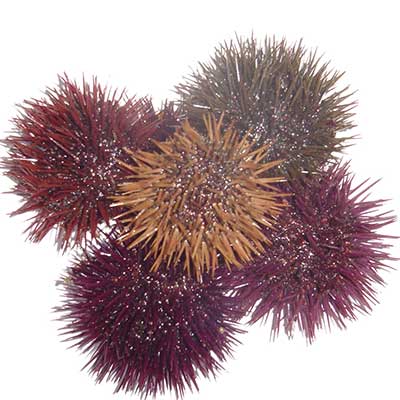
What is an urchin?
Also known as the 'chestnut' or 'hedgehog' of the sea, this animal which filters the seawater thereby removing bacteria, belongs to the echinoderm group.
They have been around for some 900 million years and there are over 800 different species around the world.
Some species are over 30 cm in diameter and some are absolutely tiny (2 mm). Their round calcium bodies (the test), covered in spines, of all sizes, can be red, purple, brown black or white.
Urchins eat algae and small animals through their buccal cavity under its body. It has three pincers to protect itself from attack, capture small prey, remove parasites and camouflage itself. Only edible urchins use these techniques.
These different species live in both warm and cold seas around the globe and can be found up to depths of 4,000 metres. They mostly live on rocky beds, but can also be found in sandy sea beds or around posidonia plants. They move at a speed of a centimetre a minute.
The male and female urchins never actually meet. In spawning periods (reproduction occurs in spring), the female releases a huge number of eggs (up to 20 million) and the male's sperm, carried by the current, fertilises any eggs it comes across.
This seafood is an important biological indicator for scientists. The concentration of urchins in a given area helps evaluate the pollution index. The urchin's genetic material is also being studied for potential cancer treatments.
Urchins have been largely ignored by the general public for a long time. They were once popular with local communities and fishermen, when they were in more abundant numbers on our coasts and found at more accessible depths.
They earned a reputation over the years for their exquisite taste and original appearance. Today they have become somewhat of a delicacy and a seafood in their own right.
The orange fingers or gonads (sex organs) can be eaten between September and April. On the Mediterranean coasts, they are known as Mediterranean coral or caviar.
A victim of its own success and breaches of fishing regulations, the urchin is now one of our coast's endangered species and one that we absolutely need to respect and protect.
Read more


Les Oursinades
In 1952, fishermen and visitors were tasting the fruits of their labour at the beach in Cap Rousset when the fishers offered the mayor at the time, Jean-Baptiste Grimaldi, his weight... in urchins.
Read more












